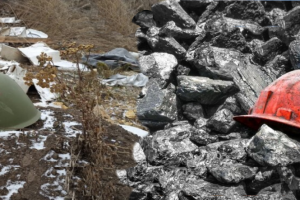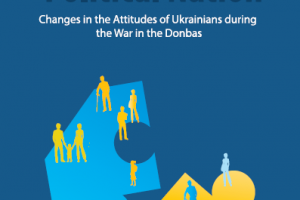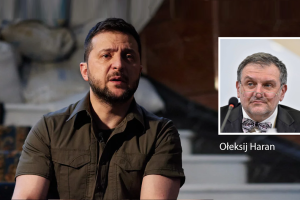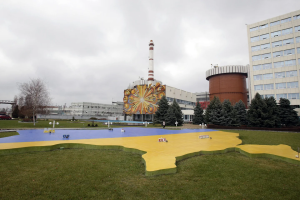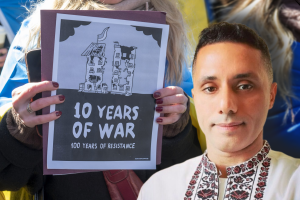Donbas Settlement and New Trends in Conflict Resolution
 Maria Zolkina, political analyst at the Ilko Kucheriv Democratic Initiatives Foundation, prepared policy brief on the Donbas for "Ukraine: Great Expectations" published by Foreign Policy Council "Ukrainian Prism"
Maria Zolkina, political analyst at the Ilko Kucheriv Democratic Initiatives Foundation, prepared policy brief on the Donbas for "Ukraine: Great Expectations" published by Foreign Policy Council "Ukrainian Prism"
After the 2019 presidential elections in Ukraine, new efforts to reset negotiations regarding Donbas conflict resolution have been taking place. The main problem of the current state of affairs lies in the field of different approaches towards the negotiations demonstrated by Russia, on the one hand, and Ukraine, on the other. Intensification of attempts to set up a new Normandy meeting comes from the Ukrainian side and faces rather visible resistance from Russia, which is more interested in bargaining, receiving as many concessions from Kyiv as possible even before the meeting. Domestic Ukrainian perceptions of possible compromises and the political future of the currently occupied territories have not changed significantly. This stability in public opinion might either limit room for manoeuvre for President Zelenskyy or serve as a political ‘airbag’ for him. It depends on the real priorities of the Ukrainian authorities in having the negotiations held. The development of the situation looks rather ambivalent now, mainly due to the lack of full understanding of what inviolable ‘red lines’ will be in practice defended by the Ukrainian president. Thus, several scenarios are possible.
A New Wave of Negotiation Efforts
The newly elected President Volodymyr Zelenskyy has started his cadence with an intensification of political and diplomatic efforts in the field of Donbas conflict resolution. Thus, major efforts have been made to ensure the organisation of the highest-level meeting in the Normandy Four format, which has not happened since 2016. The Normandy meeting is perceived as the main instrument for pushing progress in the negotiations, with the belief that personal talks with Russian President Vladimir Putin can bring an agreement on reintegration of Donbas, although the general state of affairs as well as Russia’s scenario for the conflict resolution have not significantly changed over the past years.
In particular, Moscow declares the same set of demands towards Ukraine under the general ‘politics first’ mode as previously. These are elections in the currently occupied territories, amendments to Ukraine’s constitution regarding a so-called ‘special status’ without full-fledged Ukrainian control over these territories and the Russian-Ukrainian border, in the conditions of absent security guarantees, which will be hardly provided by the Russian side. At the same time, a comprehensive ceasefire, followed by demilitarisation of those districts, withdrawal of the Russian troops, are control over the border are still perceived by the Ukrainian side as integral preconditions for political settlement. Taking into account that Russia does not demonstrate any flexibility, the only way to reach an agreement seems to be respective compromises and concessions on the side of Ukraine.
The first important trend is the uncertainty about the new red lines for Ukrainian President Volodymyr Zelenskyy. During previous years, the ‘security first’ formula was prevalent for the Ukrainian side, and that has started changing after the intensification of attempts to reach progress in negotiations with Russia. Officially, President Zelenskyy declares a comprehensive ceasefire, full demilitarisation, withdrawal of the Russian troops, and even full control over the border as his strict political preconditions for any political settlement. At the same time, there is no explanation as to which instruments Ukrainian diplomats are going to demand and insist on in order to receive guarantees for these security clauses.
The general position about what President Zelenskyy is going to present at the Normandy Four as his vision of the settlement, what compromises are not acceptable for him, and what ‘red lines’ are indeed inviolable are still lacking certainty.
The idea to establish some kind of an international mission or a temporary administration has been rejected by the president and Ukrainian negotiators in general at this stage, without an alternative option presented on who and how can organise, conduct, and verify all the demilitarisation stages and govern these territories until full restoration of the Ukrainian jurisdiction.
Withdrawal of troops in three pilot districts conducted recently also does not contribute to certainty in the ‘security first’ approach. Withdrawal cannot be considered as a fully successful initiative from the local point on view. For instance, in Stanytsya Luhanska only the Ukrainian side has fully implemented all the conditions of pullback, while the self-proclaimed ‘republics’ have not. The OSCE Special Monitoring Mission to Ukraine (SMM) has no capacity to make the other side fulfil their obligations. The official Joint Centre for Coordination and Control is also not providing full-fledged monitoring, namely because Russian officers officially left this Ukrainian-Russian format in 2017, and after that, Ukrainian officers have no full capacity to monitor what is going on in the occupied territories. At the same time, Russia and its proxies have organised some kind of a clone of the official Joint Centre for Coordination and Control, illegally composed of ‘officers’ of the self-proclaimed ‘republics’. Official attempts of Ukraine in the Minsk Trilateral Contact Group to have the Russians return to this format have been unsuccessful as of now. The newly emerged demilitarised districts are de facto ‘grey zones’, as security is still not fully guaranteed there for locals, and none of the law enforcement bodies fully operates there. Plans for further pullback process seem to be not reasonable enough, taking into account the lack of a symmetrical withdrawal in these pilot zones and of a comprehensive demilitarisation road map.
Second among the newly emerged trends is Russia’s tactics of setting preconditions and demands to Ukraine in order to organise the Normandy meeting itself.
The whole framework of negotiations about a probable meeting looked like bargaining with Ukrainian authorities in order to receive concessions without symmetric steps and obligations from Russia. That is why setting the date of the meeting has been postponed for a significant period of time, and even reaching an agreement on the date does not mean that some new demands will not arise before the meeting or at the meeting itself.
The third significant trend lies in the field of constructing a new political landscape for the implementation of the Minsk agreement, in particular, the approval of the Steinmeier formula. This proposal on de-facto simultaneous implementation of both political and security provisions of the Minsk agreements was made by former German minister of foreign affairs in 2015. Nevertheless, it has never been accepted by Ukraine as the road map for the Minsk agreements, in particular due to a lack of guarantees for fulfilment of the demilitarisation clauses on the side of Russia. Confirmation of this formula on October 1, 2019, brought new variables. In fact, Ukraine has agreed to the scheme for the special status to come into force (on the day of prospective elections in the currently occupied territories on a temporary basis, which will transform into a permanent one if the final OSCE Office for Democratic Institutions and Human Rights [ODIHR] report is generally positive).
Thus, there is a significant risk of changing emphasis in negotiations, both in the Minsk and in the Normandy format, from security to political provisions.
Neither demilitarisation of the occupied regions, nor withdrawal of the Russian troops from there has been substantively discussed and agreed upon. Entry into force of the so-called special status has been already agreed in the written form, on the other hand. Moreover, in a letter in support of the Steinmeier formula sent by all sides in September 2019, the idea of a new specific law on elections in the currently occupied districts appeared and was confirmed. In the Minsk agreements, only modalities of the future elections were mentioned, while the necessity of a specific law has never been agreed upon by the Ukrainian side.
What will this law look like and in what way will it differ from the current law on local elections in Ukraine? Will the operation of other Ukrainian official bodies be restored before such elections? Namely, the national police and judicial system are inevitable actors in the electoral process. Will the Ukrainian Central Election Commission be an organiser of these elections? Who will govern these territories before the elections? If self-proclaimed authorities, then legal Ukrainian bodies will have to cooperate with them. Anyway, there is no comprehensive road map of implementation either of the security or of the political part of the Minsk agreements.
Public Opinion in Times of Intensified Negotiations: Has Anything Changed?
Although the orientation towards compromises instead of the military way of conflict resolution has been supported by more than two-thirds of Ukrainians since 2015, only 20% are in favour of peace at any cost, while 49% believe that not all the compromises are acceptable (June 2019 public opinion poll).
Compromises that seem to be unacceptable for the largest share of the population in all the macroregions across the country, including frontline Ukraine-controlled Donbas, are elections on Russia’s and its proxies’ terms, full amnesty to illegal fighters against the Ukrainian army, and a de-facto autonomy of future local police, prosecutors, and judicial system in the occupied territories.
What compromises do you consider to be acceptable to end the war in Donbas?
| Ukraine, June 2019 | Donbas, November 2018 | |||
| Acceptable | Unacceptable | Acceptable | Unacceptable | |
| Full amnesty for those fighting against Ukrainian army | 15.5 | 61.5 | 26.9 | 45.4 |
| Holding local elections in occupied areas on militants’ conditions | 13.4 | 65.6 | 30.1 | 43.5 |
| Formation of local police, courts and prosecutors’ offices in occupied territories exclusively by local authorities | 17.7 | 58.3 | 26.7 | 41.1 |
Intensification of the dialogue with Russia has not however led to changes in the public opinion on political future of the currently occupied territories. In particular, in October 2019, 56% of Ukrainians viewed the future of these districts in Ukraine according to the pre-war political and administrative status. Moreover, the number of people ready to grant these territories more independence from central authorities or full autonomy has decreased from 29% (in July 2019) to 23.5% (in October 2019).
The so-called ‘special status’ has become unacceptable for a larger number of respondents as well. Thus, in October 2019, 56% of Ukrainians mentioned they would not support such a compromise, compared to 50% in July 2019.
As the October public opinion poll shows, people are not ready to support federalisation of Ukraine (63% are against such a measure), full amnesty (59%), rejection of the NATO membership perspective and return to the non-bloc status (54%), rejection of the European integration path (59%), recognition of annexation of Crimea in exchange for return of Donbas (70%). At the same time, there are 73% of people who are not ready for complete cession of the currently occupied territories.
Therefore, public opinion might support Ukrainian negotiators in standing for security provisions being guaranteed comprehensively before political steps. At the same time, that is a factor restraining the Ukrainian president from painful compromises, as mass rallies against the Steinmeier formula have already taken place all over the country.
Scenarios
Despite the generally proactive attitude and attempts to set up a new Normandy meeting and, in this way, to agree on some road map of the conflict resolution, the future and results of the ongoing preparations are uncertain. There are four possible basic scenarios.
Scenario 1: The meeting is held and an agreement is reached
As of now, this scenario seems to be priority number one for the Ukrainian side and represents the logic of resetting the general mode of negotiations. The main risk in this development of affairs arises from the different approaches that the Russian and Ukrainian authorities have towards preparation of this meeting. Indeed, Russia’s resistance to set up the meeting even after fulfilment of its first demands demonstrated Moscow’s rather low interest in the summit if it had no certainty about reaching an agreement. Thus, Russia’s basic expectations are to develop and agree on the scheme of conflict resolution before the meeting, while the Ukrainian authorities seem to rely mainly upon ‘live’ conversation. If one were to compare the strict negotiation position of Moscow, which aims to omit concrete security obligations and responsibilities and to push Ukraine towards political settlement and a direct dialogue with self-proclaimed authorities, with Ukraine’s rather flexible position, it becomes clear that any significant compromise might be based only on concessions on the side of Ukraine.
Lack of certainty about Ukrainian proposals for this meeting, namely, exactly what security guarantees President Zelenskyy will demand, creates instability within Ukrainian society, causes mass protests. At the same time, it might be a purposeful tactic of the Ukrainian president not to speak too precisely before the meeting. In this way, he might be trying not to lose the chance to arrange the Normandy summit if his position is really resistant to the painful compromises and if he is not going to agree to them. On the other hand, he might be trying to prevent domestic protests before the meeting if his negotiation position is to reach an agreement even on Russia’s terms. Anyway, the question of how the security clauses of the Minsk agreement will be guaranteed is not answered yet, while Russia’s logic of how the settlement should look like is clear.
Scenario 2: No significant agreement is reached. The Minsk process goes on
This scenario is possible if either the planned Normandy meeting takes place or it will not happen at all. The probability of this scenario increases along with Russia’s growing pressure on Ukraine and the necessity for the latter to decide if it is still reasonable to fulfil new demands coming from Moscow.
If there is no ground for bilateral compromise acceptable for both sides, and there is no readiness for unilateral concessions on the side of Ukraine, the status quo will be preserved. Ukraine will have to concentrate mainly on domestic public policy towards the government-controlled part of Donbas, as well as to elaborate a long-term policy of coexisting with the occupied territories in order to preserve links with ordinary people from the occupied territories. Domestic policy is not a coherent and comprehensive one and there are urgent needs to be fulfilled, especially in the frontline areas. Focus on these issues will not require any progress in negotiations with Russia, but will create a basis for reintegration whenever it starts. At the same time, negotiations in the Minsk Trilateral Contact Group will be continued.
Scenario 3: Freezing of negotiations. The Minsk and Normandy processes are set on pause
This scenario is to some extent similar to the second one, with only one difference, meaning de-facto freezing of any further attempts to push negotiations forward. That will not presuppose official termination of the Minsk agreements, but might include a search for a new, updated negotiations format or an appeal to new instruments, for instance, a return to the idea of an international mission and international administration. Concentration on domestic policy development also will take place.
Scenario 4: Withdrawal from the Minsk agreements
The idea of full withdrawal from the Minsk agreements has appeared recently and has been presented by the Ukrainian minister of foreign affairs as an alternative to complete disconnection of the Russian and Ukrainian negotiation positions, as a total failure of current attempts to reach progress. This idea is considered as the last resort out of a political deadlock, if even the current intensive efforts to reach a compromise acceptable for both sides are fully unsuccessful. This is a much stronger form or development of the previous scenario, when negotiations de facto might be stopped but no one officially will withdraw out of this format.
In the case of the most diplomatically ‘bold’ scenario, President Zelenskyy might be ready to reject the previous forms of conflict resolution. However, all the risks of losing a significant part of international support followed by difficulties in setting new formats and a new political framework should be taken into account here. That is why this idea to a large extent seems to be a counter-position towards Russia’s demands for concessions from Ukraine. If Ukraine denies moving forward along the Minsk path, it means freezing of the status quo for a long-term period. This scenario is risky not only for Ukraine, but for Russia as well, as it will lose instruments for exerting pressure on Ukraine and for pushing a beneficial for Moscow scenario for reintegration of the currently occupied territories. That is why, at the current stage, consideration of this scenario might be both a real alternative to a possible deadlock and an attempt to create a counterweight to Russia’s growing demands.
Conclusions
The intensification of negotiations with Russia in order to reach progress in Donbas conflict resolution has become one of the core issues in President Volodymyr Zelenskyy’s both domestic and international policy. The current state of affairs in this field differs from the previous logic of negotiations with the Russian Federation mainly because of lack of certainty and understanding of what the real ‘red lines’ are for the newly elected Ukrainian president and of how precisely he is going to stand up for demilitarisation, guaranteed withdrawal of the Russian troops, and return of the control over the border to Ukraine, as he declared. The lack of a presented road map of conflict resolution in these circumstances raises pessimistic expectations and fears in Ukrainian society about crossing these announced ‘red lines’ during live negotiations in the Normandy format.
Confirmation of the Steinmeier formula only in part of the procedure, the way the so-called ‘special status’ should come into force, might lead to shifting focus in the negotiations towards political settlement without a detailed security road map. Considering this new political landscape, different scenarios, varying from preserving the status quo to a full withdrawal from the Minsk agreements, look possible. The main risk arises from the position of the Ukrainian president, which is flexible and focused on reaching progress, on the one hand, and the rather hard-and-fast position of Russia, on the other. Adoption of any significant decisions in this situation is hardly possible if the Ukrainian side stands for concrete guarantees for security provisions before taking any responsibility for a political resolution. Yet, what those guarantees might look like is not clear at the moment, considering Russian resistance to accepting any direct security obligations. If no tangible progress is achieved, Ukraine might move towards the scenarios of de-facto freezing the status quo (by either continuation of the Minsk process or taking an official ‘pause’) or of withdrawal from the Minsk agreements entirely. In either case, stable public non-acceptance of reintegration on Russia’s terms should be treated by the Ukrainian president as an additional argument not to agree to ‘peace at any cost’.


